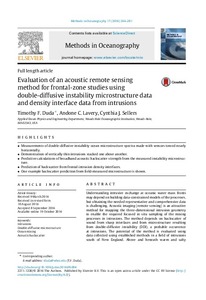| dc.contributor.author | Duda, Timothy F. | |
| dc.contributor.author | Lavery, Andone C. | |
| dc.contributor.author | Sellers, Cynthia J. | |
| dc.coverage.spatial | New England Shelf south | |
| dc.date.accessioned | 2019-04-02T19:32:00Z | |
| dc.date.available | 2019-04-02T19:32:00Z | |
| dc.date.issued | 2016 | |
| dc.identifier.citation | Duda, T.F.; Lavery, A.C. and Sellers, C.J. (2016) Evaluation of an acoustic remote sensing method for frontal-zone studies using double-diffusive instability microstructure data and density interface data from intrusions. Methods in Oceanography, 17,
pp.264-281.DOI: https://doi.org/10.1016/j.mio.2016.09.004. | en_US |
| dc.identifier.uri | http://hdl.handle.net/11329/894 | |
| dc.identifier.uri | http://dx.doi.org/10.25607/OBP-440 | |
| dc.description.abstract | Understanding intrusive exchange at oceanic water mass fronts may depend on building data-constrained models of the processes, but obtaining the needed representative and comprehensive data is challenging. Acoustic imaging (remote sensing) is an attractive method for mapping the three-dimensional intrusion geometry to enable the required focused in situ sampling of the mixing processes in intrusions. The method depends on backscatter of sound from sharp interfaces and from microstructure resulting from double-diffusive instability (DDI), a probable occurrence at intrusions. The potential of the method is evaluated using data collected using established methods in a field of intrusions south of New England. Above and beneath warm and salty intrusions may lie diffusive–convective DDI microstructure and salt-fingering microstructure, respectively, marking the intrusion boundaries, providing the backscattering features. The data show that both types of microstructure can occur in close proximity within intrusions, but the question of whether this is common or not is unanswered by the modest amount of data, as are questions about continuity of DDI-microstructure in intrusions (to facilitate intrusion acoustic imaging) and variability of DDI-driven heat, salt and buoyancy fluxes. Analysis here shows that detectable backscatter from DDI-microstructure will occur, and can be easily measured when plankton scattering is low enough. Interface scattering is also likely to be detectable. The DDI-linked microstructure data used here are inherently interesting in their own right and are presented in some detail. | en_US |
| dc.language.iso | en | en_US |
| dc.rights | Attribution 4.0 | * |
| dc.rights.uri | http://creativecommons.org/licenses/by/4.0/ | * |
| dc.subject.other | Intrusions | en_US |
| dc.subject.other | Double-diffusive microstructure | en_US |
| dc.subject.other | Ocean mixing | en_US |
| dc.subject.other | Acoustic backscatter | en_US |
| dc.subject.other | Echosounder | en_US |
| dc.title | Evaluation of an acoustic remote sensing method for frontal-zone studies using double-diffusive instability microstructure data and density interface data from intrusions. | en_US |
| dc.type | Journal Contribution | en_US |
| dc.description.notes | EchosounderSouth New England shelf | en_US |
| dc.description.refereed | Refereed | en_US |
| dc.format.pagerange | pp.264-281 | en_US |
| dc.identifier.doi | http://dx.doi.org/10.1016/j.mio.2016.09.004 | |
| dc.subject.parameterDiscipline | Parameter Discipline::Physical oceanography | en_US |
| dc.subject.instrumentType | Instrument Type Vocabulary::multi-beam echosounders | en_US |
| dc.bibliographicCitation.title | Methods in Oceanography | en_US |
| dc.bibliographicCitation.volume | 17 | en_US |
| dc.description.bptype | Guide | en_US |
| obps.contact.contactemail | tduda@whoi.edu | |
| obps.resourceurl.publisher | https://www.sciencedirect.com/science/article/pii/S221112201630007X | en_US |
 Repository of community practices in Ocean Research, Applications and Data/Information Management
Repository of community practices in Ocean Research, Applications and Data/Information Management

